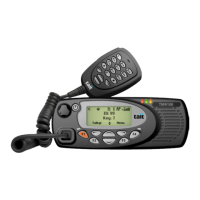TM9100 Installation Guide Installing the Radio 23
© Tait Electronics Limited August 2005
Shielding If the auxiliary cable is longer than 4 feet (1m) it is recommended that the
cable and connector backshell are shielded. Figure 2.5 shows the
recommended shielding arrangement. The earth braid wire (bare copper)
and aluminum foil should only be earthed at the radio end of the cable.
Ignition Signal The ignition signal can be used to power up and power down the radio.
This will turn the radio off when the ignition key is off to avoid flattening
the battery, and will turn the radio on or return to its previous state (as
programmed) when the ignition key is on.
Note A TMAA04-05 ignition sense kit is available. The kit comprises a
mating plug for the radio’s auxiliary connector and a 13 foot (four
metre) length of cable to connect to the vehicle’s ignition signal.
Note The AUX GPI3 line must be programmed to ‘Power Sense
(Ignition)’ and active to ‘High’. For more information, refer to the
online help of the programming application.
Connect the ignition signal to pin 4 (AUX GPI3) of the
auxiliary connector.
Note The logic thresholds for AUX GPI3 are based on 3V3 levels.
However, AUX GPI3 can be connected directly to a +13.8V
ignition signal.
Emergency Switch The radio allows for connection of an emergency switch to any input line
to enter the emergency mode. If connected to the AUX GPI2 input line,
the radio can also use ‘emergency power sense’ to power up the radio to
enter the emergency mode.
Note The selected input line must be programmed to ‘Enter Emergency
Mode’ and active to ‘Low’. To use ‘emergency power sense’,
hardware link LK3 must be fitted (factory default), and AUX GPI2
Figure 2.5 Auxiliary cable and connector shielding
metal D-range shroud in
contact with backshell
metal backshell
signal earth wire
aluminum foil
cable insulation
metal cable clamp
earth braid wire
analog ground pin

